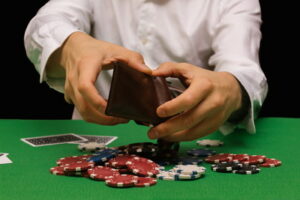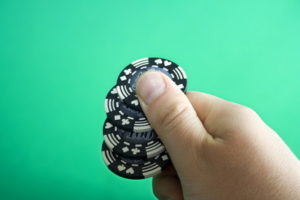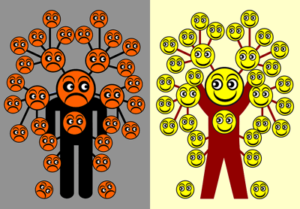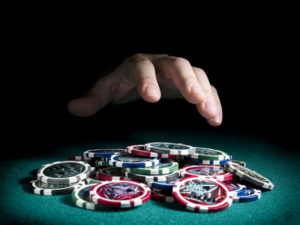 Pot control is a move that is designed to stop the pot getting too big for your hand. It is when the player, very often in position, takes a submissive line by checking or calling with a decent but not great hand so that they can control the size of the pot. At first, this might seem a little strange way to behave given the object of poker is to take other people’s money and as much of it as we can get however there are justified reasons for exercising pot control.
Pot control is a move that is designed to stop the pot getting too big for your hand. It is when the player, very often in position, takes a submissive line by checking or calling with a decent but not great hand so that they can control the size of the pot. At first, this might seem a little strange way to behave given the object of poker is to take other people’s money and as much of it as we can get however there are justified reasons for exercising pot control.
Controlling the pot is basically the act of keeping the size of the pot small and more manageable. Typically, players utilise pot control by checking behind on flops and turns when they have semi strong hands in order to avoid making the pot too large. And while this can make sense on the face of it, it can also create a whole host of problems in your strategy so make sure you understand it.
The theory behind pot control is that if you have a middling hand then it is a bad idea to build up the pot too high in case you end up facing a tough decision on the river. For this reason, players will often pot control by checking back when they have been checked themselves. If they face bets or make bets on the turn, they will be smaller in size which makes it far easier to call a pot sized river bet with a pair of nines after they have previously missed a street or two of betting.
Big Hand, Big Pot, Small Hand, Small Pot
 To explain, an old poker maxim runs thus: big hand, big pot, small hand, small pot. The idea being that poker players want to tailor the size of the pot according to the strength of their hand. This is done by betting and raising when they have a monster and checking and calling when holding a hand of medium strength.
To explain, an old poker maxim runs thus: big hand, big pot, small hand, small pot. The idea being that poker players want to tailor the size of the pot according to the strength of their hand. This is done by betting and raising when they have a monster and checking and calling when holding a hand of medium strength.
And while pot control can be important, it needs to be balanced against other considerations. Obviously, choosing the most profitable option will be your most important aim. Often, keeping the pot small and attempting to make it to showdown can interfere with maximal profitable play. Take, for example, a six handed NLHE game with £1/£2 blinds. In this scenario, you open raise one off the button to £7 holding QQ. Only the small blind calls and you both have $200 behind.
The flop delivers 6S, 8S, JD. Your opponent checks, you bet £12, and he calls. 7D drops on the turn and if your opponent is holding, say, 9-7, 8-7, 7-6 or 5-4, then he is in poll to beat your queens. There is also the concern that he may have J-8, 8-6, or even a flopped set. In short, your over pair no longer feels like the monster it once did. The small blind checks so what now?
Here, many players will check back for pot control meaning that they are keeping the pot small. The worry being that if they bet, their opponent may check raise or make a big bet on the river that they will be unable to call. So instead, often players will check with the intention of calling a bet on most rivers.
Fearing A Check Raise

It can make sense to fear a check raise. Your opponent could very easily be holding a strong hand. If so, your will not be good enough to call, in which case a check raise will cost you the pot. However, in another sense, fearing the check raise makes no sense. Should it come, you are almost guaranteed to be beaten with not very much chance of improving.
From your opponent’s point of view, you have been displaying consistent strength, betting or raising every chance you got. As far as he is aware, you could be holding two pair, trips or even a straight. His check raise won’t be a bluff meaning that you probably weren’t going to win regardless. All you lose is your bet, which you would have lost anyway seeing as you were always likely to call a river bet.
A check raise bluff or a check raise that forces you to muck a good draw is something to worry about. This is because the raise costs you not only your bet but also your pot equity when you fold a hand that could have gone on to win at showdown.
The Advantages Of Pot Control
 Now that we have taken a look at the disadvantages of betting and downplayed them, let’s look into the advantages.
Now that we have taken a look at the disadvantages of betting and downplayed them, let’s look into the advantages.
Many worse hands, such as paired jacks, will probably call a river bet. Others, however, say 9-8, 9-7, 9-6, 7-5, 6-5 and flush draws might call the turn in the hopes of improving the situation but would never bluff or pay off on a river bet if unimproved when you check the turn.
Even if your opponent folds, you are still protected against draws and bluffs when it comes to scary river cards. If you did check the turn, would you then be happy about facing a pot sized bet on a 9s river?
Sometimes Pot Control Can Make Sense
![]() Betting will often you up to a bluff that you cannot call or it can force you off of a good draw meaning that you should check in an attempt to see the river or showdown on the cheap. Likewise, if you suspect that a check will often lead to a river bluff or a looser call that your opponent would have made on the turn.
Betting will often you up to a bluff that you cannot call or it can force you off of a good draw meaning that you should check in an attempt to see the river or showdown on the cheap. Likewise, if you suspect that a check will often lead to a river bluff or a looser call that your opponent would have made on the turn.
Pot control is all about making profitable decisions. There is no law in the game stating that you must check your one pair hands on the turn or showdown with every over pair. Instead, you need to weigh the costs and benefits of betting. Will a bet lead your opponent to make mistakes, or might it open you up to making a costly mistake yourself?
The Wrong Way To Use Pot Control
 Sometimes pot control can be misunderstood and misapplied and a lot of poker players are going to use it simply to justify their nitty play. These are also the same guys that will only help to build big pots when they are holding monster hands and are never going to build a medium to large pot when they have a single pair or a bluff.
Sometimes pot control can be misunderstood and misapplied and a lot of poker players are going to use it simply to justify their nitty play. These are also the same guys that will only help to build big pots when they are holding monster hands and are never going to build a medium to large pot when they have a single pair or a bluff.
So, instead, they make it clear and obvious that they will focus on pot control unless, of course, they do have the nuts in which case they want the pot to expand. These players can be very easy to get a read on. When the only reason a player is using pot control is because their opponent could be holding a stronger hand, it is highly likely the person doesn’t completely understand pot control at all or only slightly at the very least.
Using Pot Control Conclusion
 Understand pot control concepts and know when to and when not to utilise it. Focus not on worrying about losing the pot can concentrate on positive estimated value decisions instead. A lot of poker players use pot control simply because they are scared that their opponent might have them beaten or check, raise them off a hand as a bluff.
Understand pot control concepts and know when to and when not to utilise it. Focus not on worrying about losing the pot can concentrate on positive estimated value decisions instead. A lot of poker players use pot control simply because they are scared that their opponent might have them beaten or check, raise them off a hand as a bluff.
That is definitely a mistake as not only do you lose out on value with good hands, but you also let off your opponents with free cards to outdraw you which is why pot controlling on lively boards is a bad idea. You don’t need to fear being re raised because, while it might well be a bluff, a lot of the time it means that you were likely to be behind anyway.
If you are going to use pot control then you will need to occasionally play your very big hands in the same way. You will occasionally need to have sets in your pot control range, because if you don’t your opponents will pick up on the fact that you are making an attempt to get to the showdown on the cheap and they will pile on the pressure with multi street bets.
At the end of the day, pot controlling can be a very useful strategy, especially when trying to survive in tournaments. However, many amateur poker players use pot control more to mask risk aversion in their game. If you do use pot controlling as a poker strategy, make sure you check with yourself if you are losing out on value and asking yourself whether or not you should instead be looking to get another bet in.
